This study is the first report on the effectiveness of dietary bromelain in mitigating AHPND and probably other Vibrio-related diseases in shrimp
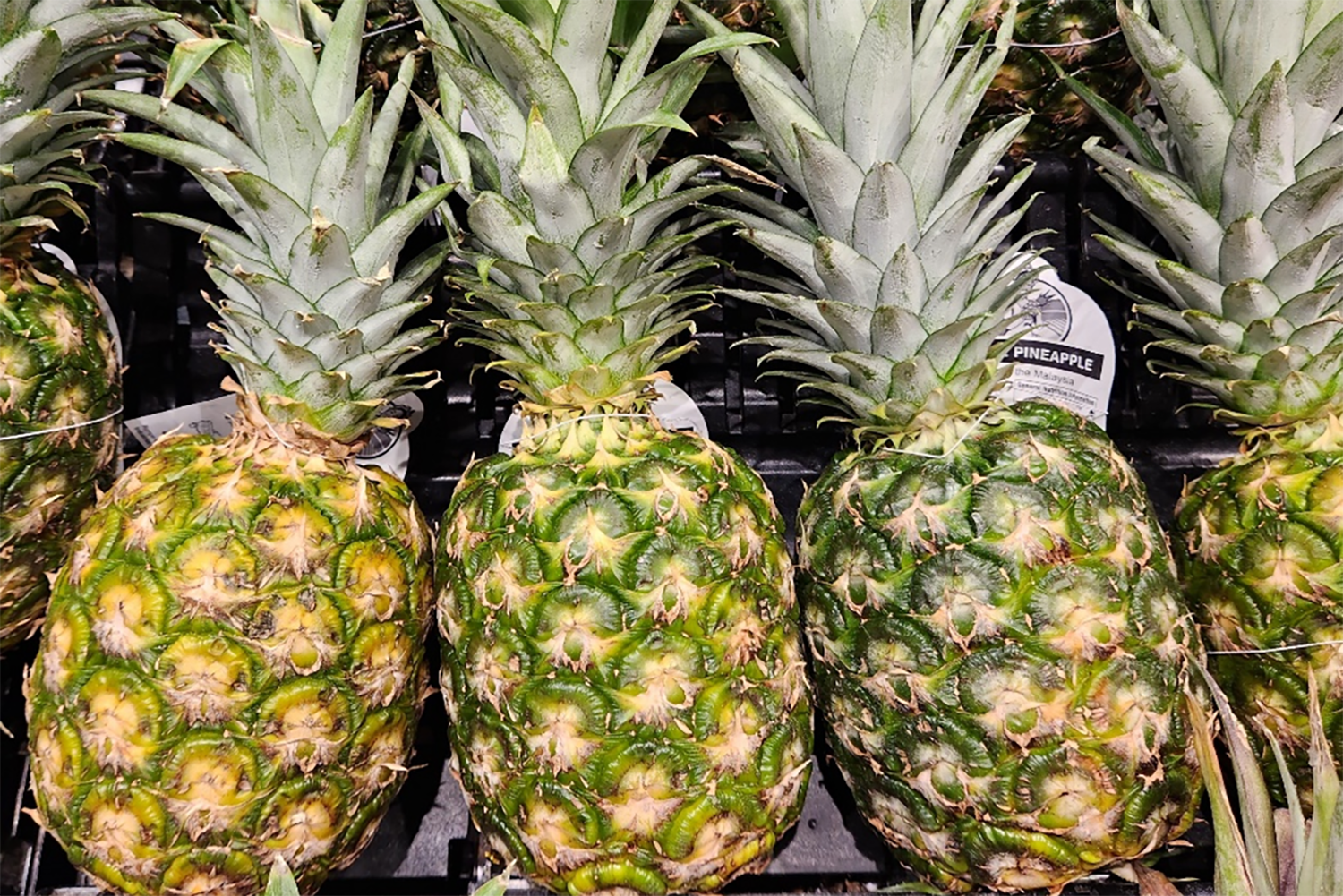
The widespread use of specific pathogen free (SPF) stocks of domesticated Pacific white shrimp (Penaeus vannamei) has greatly reduced the carrier for many viral diseases. However, bacterial diseases continue to be a problem and limit the productivity of many shrimp farms. In recent years, the emergence of a bacterial disease called acute hepatopancreatic necrosis disease (AHPND) has caused major economic losses to shrimp farmers at the grow-out stage. It was first detected in China (2009) and spread sequentially in the next three years to Vietnam, Malaysia and Thailand, then to Mexico (2013) and the Philippines (2014) before being reported in South America and South Korea in 2016, Bangladesh and USA in 2017 and Costa Rica in 2020. An infectious disease spreading across countries and continents, AHPND is a bacterial pandemic in the shrimp farming world.
The emergence of AHPND has led to increased use of antibiotics in Asia, and as a consequence, AHPND-causing bacteria have been reported to show antibiotic resistance to a wide range of antibiotics including plasmid-mediated tetracycline resistance in V. parahaemolyticus. Due to environmental and human health concerns associated with excessive antibiotic use, plant-based feed additives, collectively known as phytogenics or phytobiotics, are increasingly being viewed as potential alternatives to antibiotics.
The efficacy of various plant extracts in mitigating AHPND in shrimp is due to the action of their various bioactive compounds. We recently investigated the potential of pineapple (Ananas comosus) extracts; the prevalent bioactive compound present in the extract of pineapple is bromelain. Studies have reported that bromelain exhibits various enzymatic, anti-edematous, anti-thrombotic and anti-inflammatory activities among other human health-promoting benefits.
Of particular interest in animal nutrition is the anti-bacterial properties of bromelain, reported to inhibit the growth of intestinal pathogens such as Vibrio cholera and Escherichia coli; bromelain inhibits bacterial toxin production, thus preventing diarrhea caused by E. coli and V. cholera in animals. Even though the exact mode of action is not known, it has been speculated this effect of bromelain is achieved by interacting with intestinal secretory signaling pathways or due to anti-adhesion effects, possibly by proteolytically altering receptor sites which prevented pathogenic bacteria from attaching to receptors located on the intestinal mucosa.
Considering the fact that bromelain is effective against the protein toxins of E. coli and V. cholera which target the digestive tract of animals and with the cholera toxin being a member of the AB toxin family, we decided to investigate whether bromelain might also be effective against AHPND which is caused by the PirAB protein toxin targeting the digestive system (hepatopancreas) of shrimp. This is the first report on the efficacy of bromelain in the control of Vibrio diseases, including AHPND, in P. vannamei shrimp.
Feeding trial and disease challenge
Four practical diets were produced using a commercial shrimp post-larval feed (Post Larva II crumbles #902, Gold Coin Specialities Ltd., Malaysia) as the base formulation. The use of a commercial shrimp feed as the base allowed us to evaluate the actual potential efficacy of bromelain, should it be added to commercial feeds. The commercial shrimp feed was ground into fine powder before being re-pelleted. The positive (posCON) and negative (negCON) control diets consisted of the re-pelleted commercial shrimp feed with the addition of a pellet binder (Pegabind®, Bentoli AgriNutrition Co., Ltd., Thailand). Only the shrimp fed the posCON diet was later challenged with V. parahaemolyticus (VPAHPND). Two other diets with the inclusion of 1 percent (1% BM) or 2 percent (2% BM) bromelain-based powder extracted from pineapples (Anatara Lifesciences Ltd., Brisbane, Australia) at the expense of alpha-cellulose were also pelleted. The control diets had no added BM.
Quadruplicate groups of shrimp were hand-fed with their respective diet three times daily to apparent satiation for 28 days. After the growth trial was completed, shrimp from each dietary treatment were removed from each aquarium, pooled and then re-stocked in each aquarium for the disease challenge trial.
The first AHPND challenge trial used 23 shrimp per replicate (four replicates for each diet) for ten days. After the first disease challenge, the surviving shrimp were pooled by dietary treatment and re-arranged to 15 shrimp per replicate with three replicates. All shrimp were switched to the control diet (0% BM) for 14 days before being re-challenged with AHPND. This was considered the wash-out period and used as an indirect way to observe if prior dietary bromelain supplementation had a longer-term effect on shrimp health. Thereafter, the second AHPND challenge was conducted for another 10 days. The schedule of the feeding trial, wash-out period and AHPND challenge tests are as sequentially illustrated in Fig. 1.
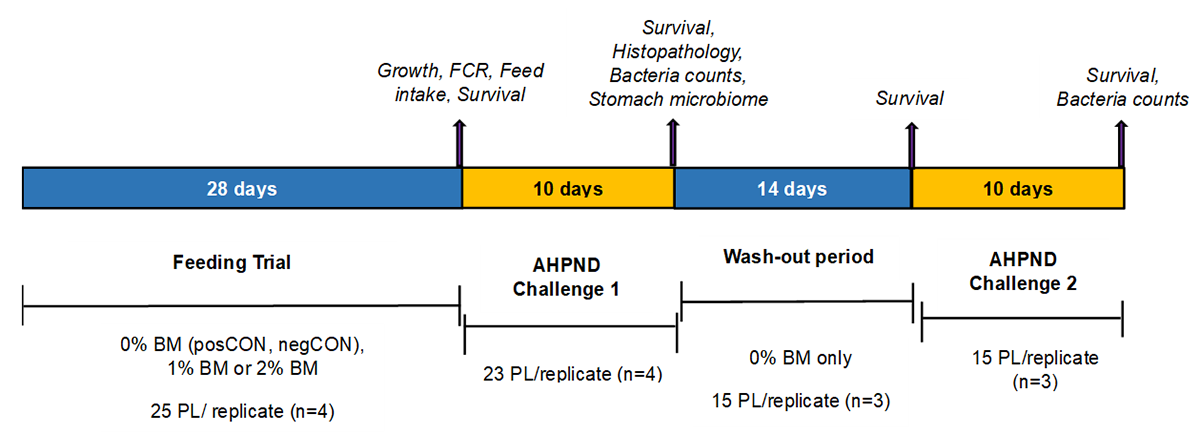
The disease challenge was carried out using the immersion method. Shrimp from each aquarium in the posCON, 1%BM or 2%BM groups were placed for 15 min (with aeration) in a 1-liter Erlenmeyer flask containing 150 mL of VPAHPND culture (108 CFU/mL). Then, the bacterial suspension including shrimp was poured directly back into their respective aquarium containing clean artificial seawater. The negative control treatment (negCON) was included to serve as an environmental control and the shrimp were not challenged with VPAHPND but immersed in sterile tryptic soy broth plus 1.5 percent NaCl. All shrimp were observed every three hours to monitor gross clinical signs and mortality.
Comprehensive details on the methodologies used and results can be found in the original publication [Ng, W-K and M-L Mong. 2024. Dietary bromelain from pineapple extracts enhanced growth performance and modulated stomach microbiota which provided longer-term protection to Penaeus vannamei against acute hepatopancreatic necrosis disease (AHPND) caused by Vibrio parahaemolyticus. Aquaculture Research 2024, Article ID 6492170, 14 pp.
The efficacy of bromelain phytochemicals
The growth performance of shrimp fed bromelain-added diets improved over the control groups. In particular, shrimp fed with 2% BM mostly had significantly higher (P < 0.05) final weight, percent weight gain, daily weight gain, specific growth rate and feed intake than shrimp fed with the control diets. Nevertheless, growth performance was not significantly higher (P > 0.05) compared to the 1% BM-fed shrimp. The feed conversion ratio (FCR) was excellent with values close to 1.0 across diets, and shrimp survival rates were high (95–100 percent).
The negCON (not challenged with AHPND) showed 95-98 percent shrimp survival over the two disease challenge trials, which confirmed that the procedures and experimental systems used in the present study did not markedly stress the shrimp or caused them to be susceptible to unwanted mortality. In the first AHPND challenge, shrimp fed the 1% BM diet showed the highest survival (84.8 ± 3.8 percent), followed by 2% BM (78.3 ± 2.5 percent), which were both significantly higher compared to the posCON group (69.5 ± 1.8 percent) (Figure 2). After the wash-out period and re-challenging the shrimp with AHPND (second AHPND challenge), shrimp previously fed 1% or 2% BM showed significantly higher survival at 71.1 ± 9.7 percent and 73.3 ± 3.8 percent, respectively, compared to posCON group which had the lowest survival at 51.1 ± 2.2 percent (Fig. 2).
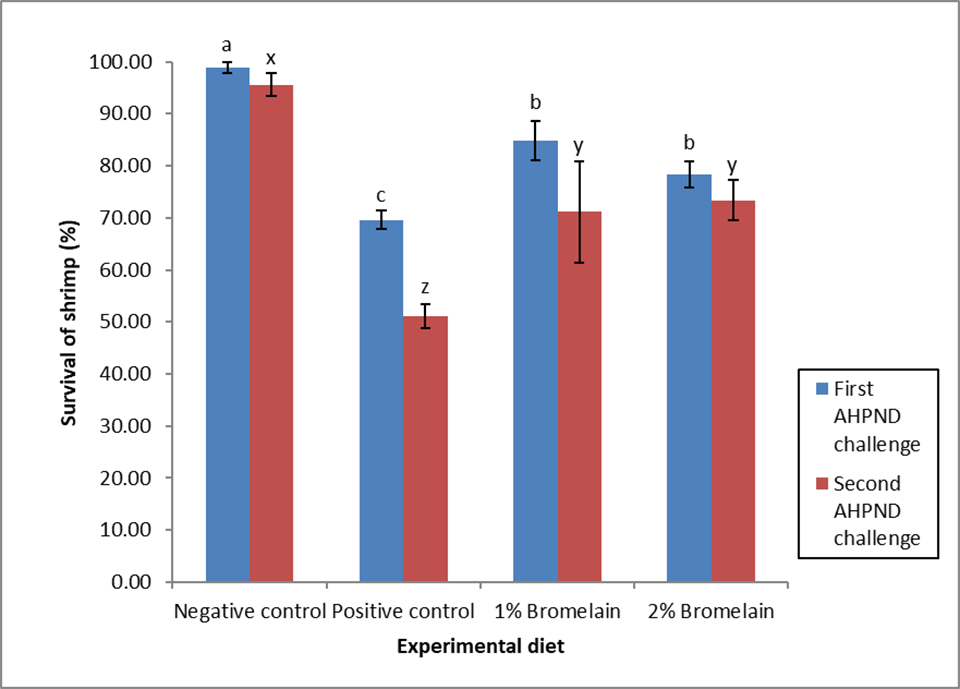
The results showed that the addition of 2% BM significantly lowered the average percentage survival difference (3.5 percent) between first and second AHPND challenge compared to the posCON group (18.5 percent), whereas 1% BM-fed shrimp was 14.4 percent. Considering that the difference in shrimp survival between the first and second AHPND challenges for the negCON group was about 3.0 percent, the small increase in shrimp mortality observed in the 2% BM group during the second disease challenge might not be due to AHPND per se. Shrimp mortality was caused by damaged hepatopancreas (Figure 3).
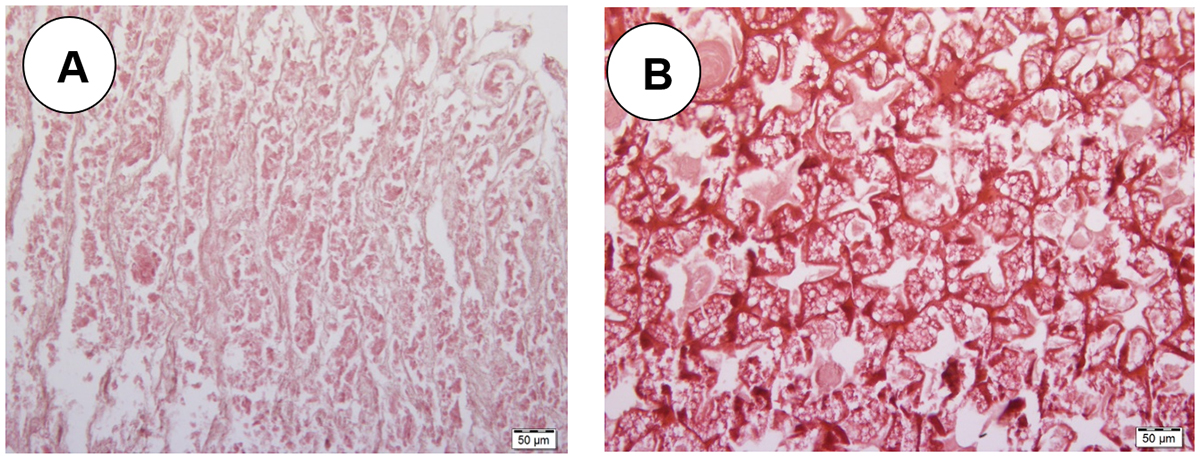
Stomach microbiota
Gut microbiota is known to be involved in the regulation of shrimp health and disease. The stomach bacterial community of VPAHPND-infected shrimp fed the BM-supplemented diets showed the highest alpha diversity according to the Simpson Index. A high Simpson index indicates a high number of ASV (amplicon sequence variant) and more similar proportions of ASV. The bacterial diversity in the posCON group was the lowest of all groups and was depressed compared to the unchallenged shrimp in the negCON group.
At the phylum level, bacterial community structure consisted mainly of Proteobacteria, Actinobacteria and Bacteroidetes in relative abundance across all treatment groups (Figure 4). The posCON group had an increased relative abundance of Tenericutes and Bacteroidetes with a decreased relative abundance of Actinobacteria compared to the unchallenged negCON group. Compared to the posCON group, the bacterial community in the stomach of shrimp fed 1% BM diet showed increased relative abundance of Verrucomicrobia and Planctomycetes with a corresponding decrease in the relative abundance of Tenericutes. For the 2% BM group, a significant enrichment of the Proteobacteria was observed in the stomach with a decrease in the abundance of Tenericutes.
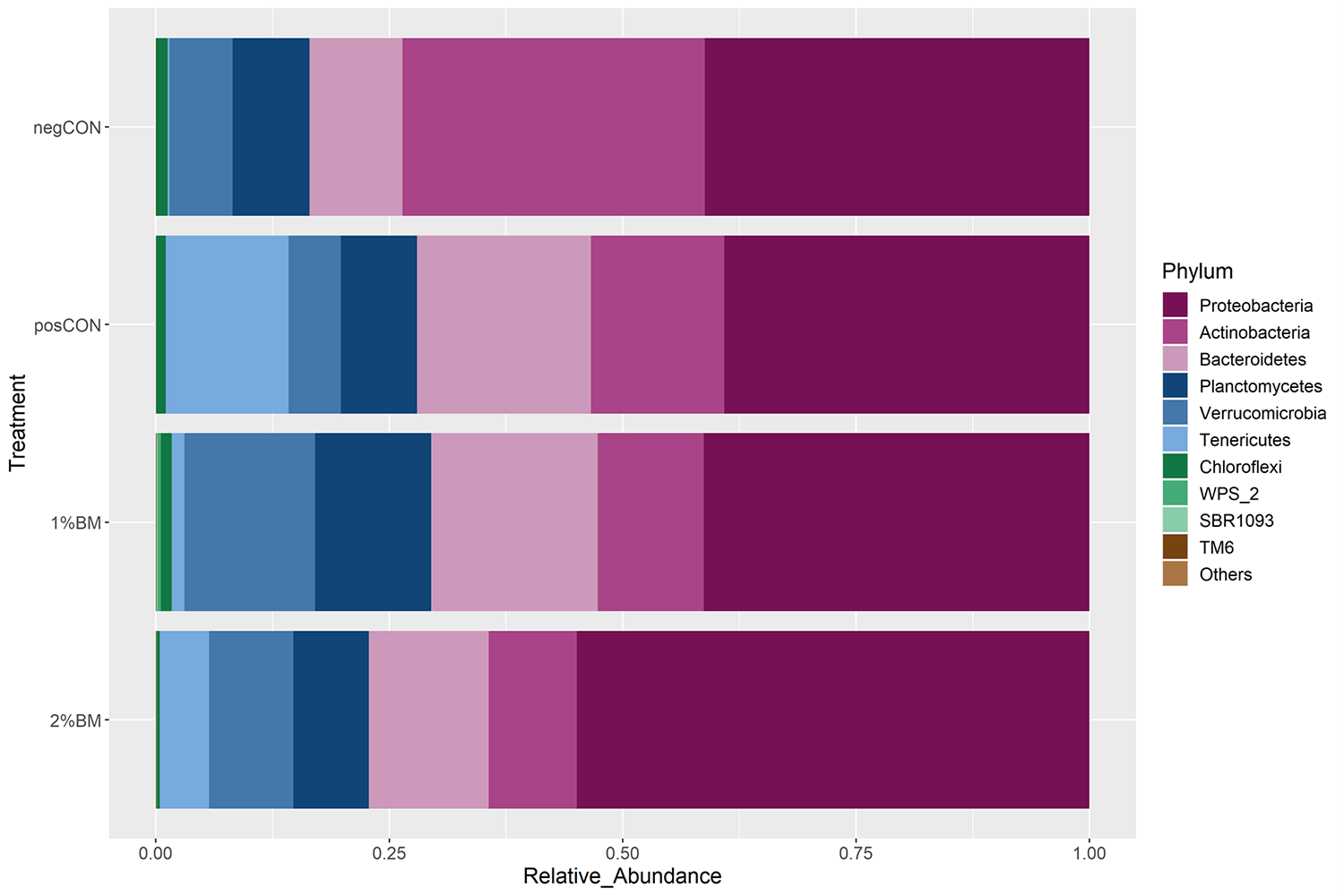
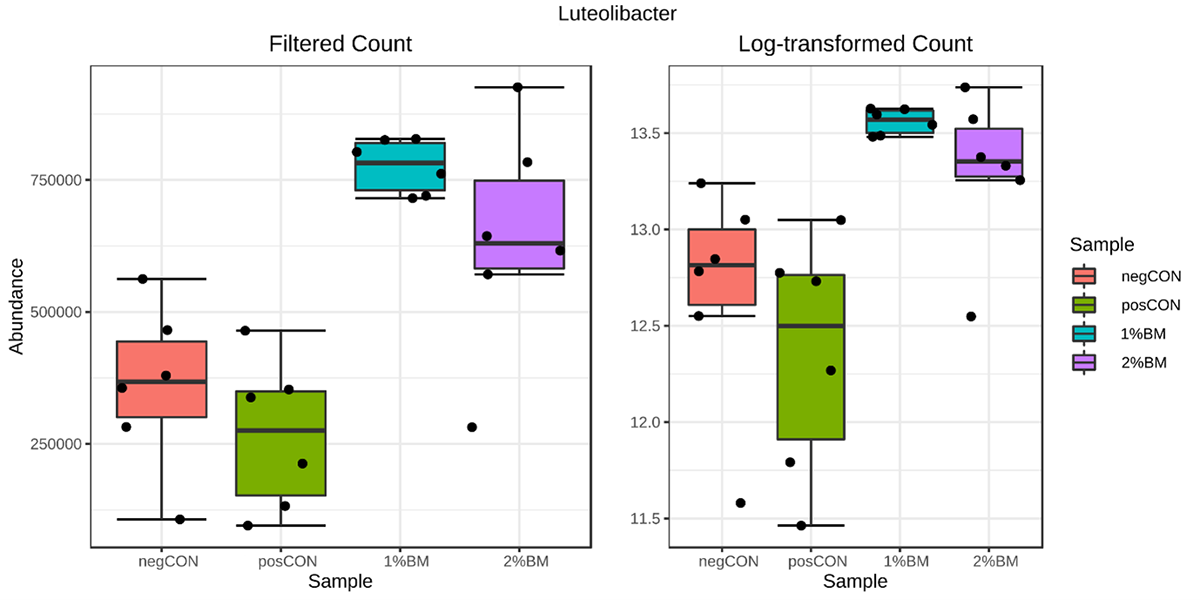
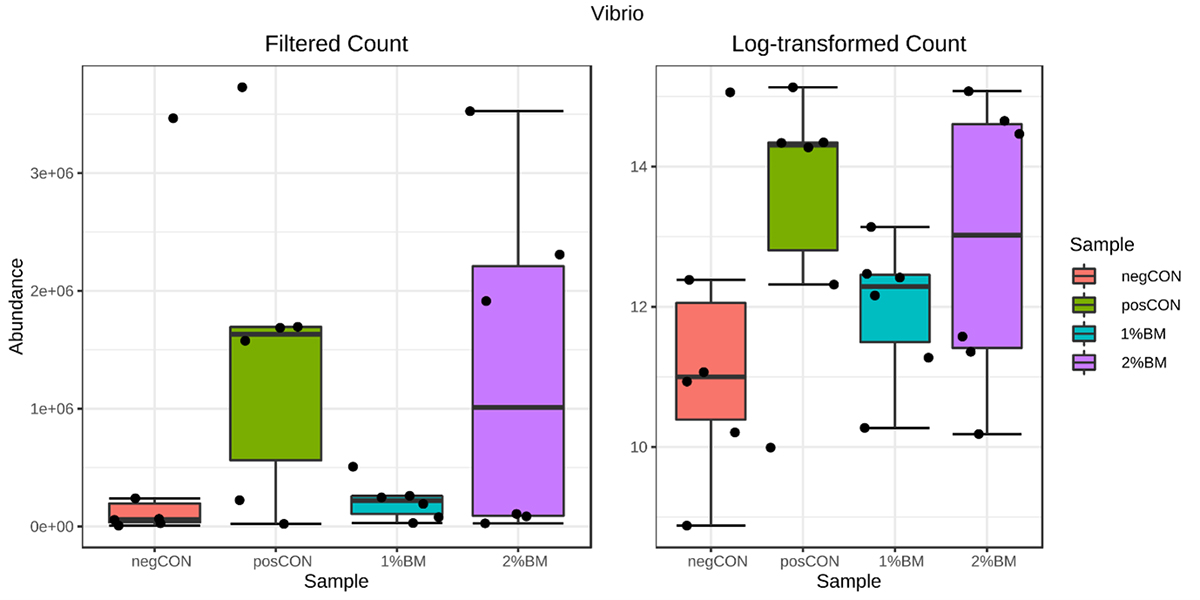
The potential of bromelain phytochemicals
Bromelain is an enzyme complex consisting of a mixture of different thiol endopeptidases with other minor components such as phosphatases, cellulases, glucosidase, peroxidases, glycoproteins, carbohydrates, etc. Bromelain is the predominant sulfhydryl proteolytic enzyme present in pineapple. Commercial bromelain is mostly extracted from the stem and fruit of pineapples, but it can also be isolated in small quantities from pineapple wastes such as leaves, peels and crowns. Stem bromelain (EC 3.4.22.32) is known to exhibit different biochemical properties, biological activity and composition compared to fruit bromelain (EC 3.4.22.33). Comparisons of research studies conducted with bromelain should therefore consider which part of the pineapple was used for extraction, the resultant enzyme activity, composition and purity of the bromelain product. Furthermore, studies conducted using crude extracts from various pineapple parts instead of purified bromelain will also contain other minor bioactive compounds such as saponins, flavonoids, alkaloids and tannins which may compound research findings.
Very little information is currently available on the impact of dietary BM on the growth performance of aquatic animals. The present growth trial showed that bromelain supplementation in the feeds of white shrimp generally enhanced growth performance, especially at the 2% BM dietary level. The addition of bromelain up to 2% of the diet did not cause any feed palatability or toxicity issues, as evidenced by the high survival of shrimp with excellent feed intake and FCR observed. The improved growth performance of shrimp fed BM-added diets could be due in part to the improved health status of shrimp. Other factors contributing to the growth improvement observed in the present study may include enhancement of nutrient digestibility and/or beneficial changes to gut morphology that would allow better nutrient absorption.
The present study is the first report on the effectiveness of dietary bromelain in mitigating AHPND and probably other Vibrio-related diseases in shrimp. Presumptive Vibrio counts and total cultivable bacteria counts in the hepatopancreas of shrimp previously fed with BM-supplemented diets were significantly lower than positive control after both AHPND challenge tests. The prevalence of Vibrio bacteria in the stomach of shrimp fed BM-added diets were also markedly lower compared to posCON (Fig. 6).
The exact anti-bacterial mode of action of bromelain is currently not known. Results from the present study contributed to a better understanding of the mode of action of bromelain. By introducing a wash-out period of 14 days where all shrimp were switched to the control diet (no bromelain) before the second AHPND challenge, we were able to show that disease resistance in shrimp was not totally dependent on the direct actual presence of bromelain in the shrimp body. Dietary bromelain supplementation was shown to have the ability to impart a long-lasting beneficial effect on shrimp health. In the 2% BM group, shrimp survival in the first and second AHPND challenge was almost the same after accounting for mortality encountered in the negative control unchallenged group (Figure 2). In the posCON group, the second AHPND challenge resulted in a further 18.5 percent drop in shrimp survival resulting in a cumulative survival of only 51.1 percent.
The greater mortality observed in the second AHPND challenge compared to the first disease challenge in the posCON group is not unexpected since shrimp do not have adaptive immunity which creates immunological memory for enhanced response to secondary exposure with the same pathogen. Shrimp in the posCON group were likely weakened by the first disease challenge which resulted in higher mortalities when challenged a second time.
Moringa leaf extract can boost Pacific white shrimp immune responses
Based on the results from the present study, we hypothesized that the anti-bacterial mode of action of bromelain might not be fully dependent on direct inhibitory actions of bromelain on the invading pathogens. In human studies, it was reported that the plasma half-life of bromelain was 6 to 9 hours. Due to its short half-life, bromelain is not expected to bioaccumulate in tissues. Since AHPND infection is via colonization of the pathogenic Vibrio bacteria in the shrimp stomach, positive changes to gut microbiota modulated by dietary bromelain might have provided a longer-lasting effect in maintaining health and better immune response to shrimp when challenged with AHPND.
Perspectives
The present study provided the first evidence of the role and importance of a diversified stomach microbiota in maintaining the health of shrimp and its ability to resist AHPND infection even without the direct actual presence of dietary phytochemicals such as bromelain. The protective properties of dietary bromelain were retained in shrimp even after switching to the control diet with no added bromelain for two weeks (wash-out period) before the second AHPND challenge.
The highest alpha diversity was observed in VPAHPND-infected shrimp fed the bromelain-added diets. Relative changes in the stomach bacterial community were evident among the treatment groups. Bacteria of the genera Luteolibacter, Paracoccus, Planctomyces and Demequina contributed significantly to the diversity differences among treatment groups and was especially enriched in the BM-fed groups. The actual roles performed by these bacterial community changes remain to be investigated.
In conclusion, the present study showed that gut microbiota manipulation through the use of phytochemicals such as bromelain can be an alternative to harmful broad-spectrum antibiotics in the disease management of farmed shrimp against AHPND and possibly other Vibrio diseases. Based on these laboratory results, we recommend a dietary bromelain level of 2% for both enhanced growth performance and disease resistance against AHPND.
Now that you've reached the end of the article ...
… please consider supporting GSA’s mission to advance responsible seafood practices through education, advocacy and third-party assurances. The Advocate aims to document the evolution of responsible seafood practices and share the expansive knowledge of our vast network of contributors.
By becoming a Global Seafood Alliance member, you’re ensuring that all of the pre-competitive work we do through member benefits, resources and events can continue. Individual membership costs just $50 a year.
Not a GSA member? Join us.
Authors
-

Wing-Keong Ng, PhD, FASc
Corresponding author
Asian Aquafeeds Services, Penang, Malaysia; retired professor, Universiti Sains Malaysia, Penang, Malaysia -

Mei-Ling Mong, MSc
School of Biological Sciences, Universiti Sains Malaysia, Penang, Malaysia
Tagged With
Related Posts

Health & Welfare
A holistic management approach to EMS
Early Mortality Syndrome has devastated farmed shrimp in Asia and Latin America. With better understanding of the pathogen and the development and improvement of novel strategies, shrimp farmers are now able to better manage the disease.
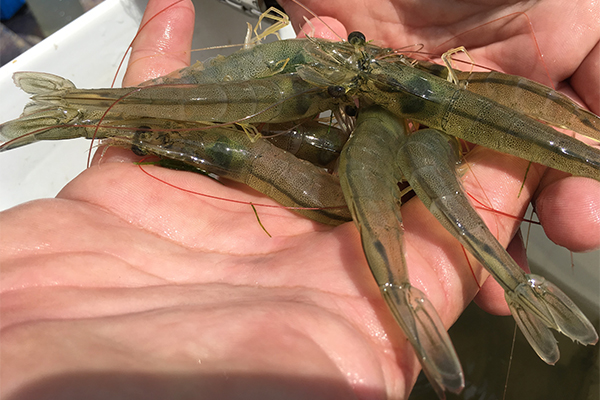
Health & Welfare
Effect of nucleotides on immunoregulation and AHPND resistance in Pacific white shrimp
Including a commercial nucleotide in L. vannamei diets improved growth, survival, immune response, resistance to AHPND and profitability.
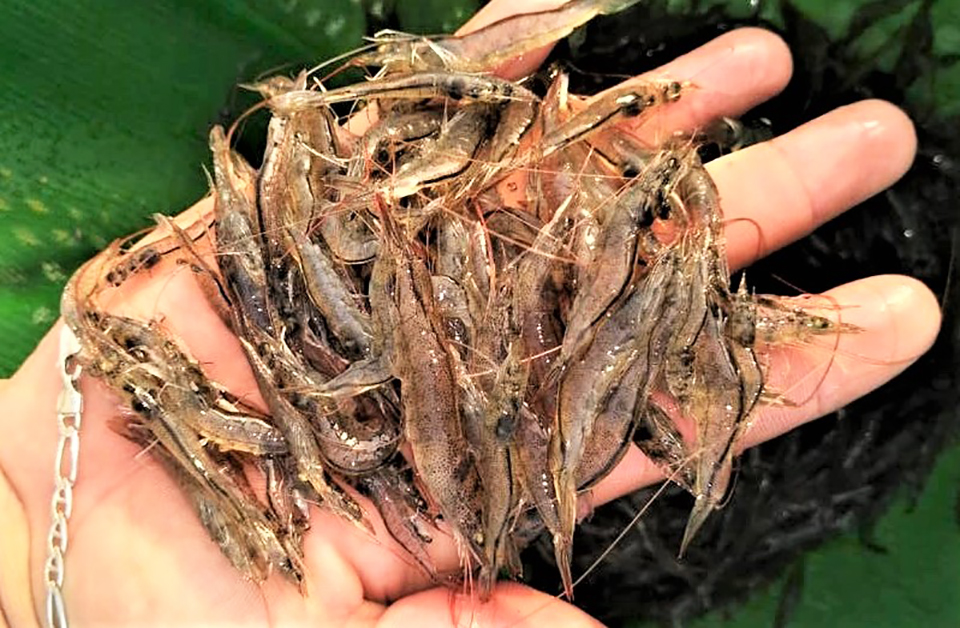
Health & Welfare
Gut microbiota modulation of Pacific white shrimp by dietary inclusion of a functional yeast cell wall‐based additive
Evaluating gut microbiota modulation in L. vannamei through dietary yeast cell wall additive improves animal performance, healthy intestinal microbiota.
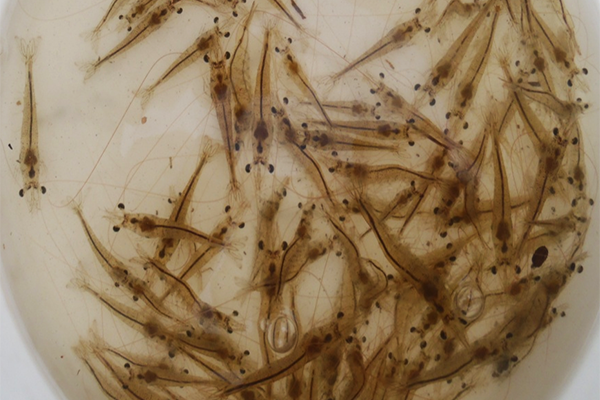
Health & Welfare
Benefits of dietary tartaric acid on the growth, nutrition and immune response of Pacific white shrimp
Dietary tartaric acid improved shrimp growth markers and defense systems with improvements in feed utilization, immunity and disease resistance.


